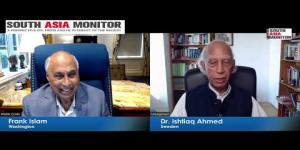25 Years of Pokhran II Tests: Thinking beyond nuclear deterrence in South Asia
The lesson one can draw from 25 years of nuclear South Asia is that nuclear weapons are guarantors of stability at the highest or strategic levels, but they are certainly not the panacea to the security challenges faced by a nation, especially at the sub-conventional level. The case of the India-Pakistan conflict validates this point

On 11th and 13th May, 1998, India surprised the world by conducting five nuclear tests in the deserts of Pokhran, Rajasthan. The tests put an end to years of ambivalence that characterized India’s nuclear program since the 1974 Peaceful Nuclear Explosion (PNE). The rationale behind India’s decision of going overtly nuclear was well explained by then Prime Minister Atal Bihari Vajpayee in his letter to US President Bill Clinton. Vajpayee cited the growing threats to India’s security in the neighbourhood ever since China went nuclear in 1964. India had outstanding border disputes with China and had also fought a war with its eastern neighbour in 1962. Moreover, China was also helping Pakistan throughout the 1980s and 1990s to acquire nuclear weapons capability by covertly supplying nuclear designs and highly enriched uranium (HEU) to Islamabad. This was a serious security concern for India as Pakistan being emboldened by its growing nuclear capabilities had started to foment insurgency in Punjab and Kashmir. Therefore, the urgency of possessing a credible nuclear deterrent was growing large on India if it had to thwart nuclear blackmailing or coercion from its hostile neighbours.
Apart from the issues of security, India was also increasingly coming under pressure from the nuclear non-proliferation regime to join the Non-Proliferation Treaty (NPT) as a non-nuclear weapons state and also sign the Comprehensive Test Ban Treaty (CTBT) in the mid-1990s. Also, the NPT was indefinitely extended in 1995. This meant that the scope for India to develop its own nuclear weapons was getting circumscribed. Hence, the combination of security threats and pressure from the powerful non-proliferation regime - which India considered to be discriminatory - were the twin reasons responsible for India shedding its nuclear ambiguity in May 1998.
This year marks the 25th anniversary of Pokhran II tests and it provides an opportunity to have a look at how India’s credible minimum deterrent threat has played out in all these years.
This paper will seek to critically evaluate the deterrence value of India’s nuclear weapons, and whether it has been able to deter the threats emanating from India’s major adversary Pakistan with a specific focus on the issue of cross-border terrorism. The paper will also argue that while nuclear weapons come in handy in deterring the use or threat of use of nuclear weapons by rival nations their deterrent value gets limited when it comes to preventing lower levels of violence like sub-conventional or unconventional warfare. This is what we have witnessed in South Asia since the overt nuclearization of the region in 1998. Pakistan has persisted with its strategy of using proxy war to bleed India without being dissuaded by the latter’s nuclear capability. The paper will point out that the more effective strategy of engaging with Pakistan-sponsored cross-border terrorism lies at the conventional and sub-conventional levels. As nuclear weapons have made the option of all-out war obsolete, India can no more count on a large-scale military offensive against Pakistan but at the same time it can plan for punitive strikes that do not breach the nuclear redlines of Pakistan. The surgical strikes of 2016 and the Balakot airstrikes of 2019 are examples of this. Calibrated military responses backed by consistent diplomatic offensives seem to be the most suitable approach to deal with cross-border terrorism in a nuclearized environment.
Nuclear weapons and sub-conventional warfare
Indian policymakers were quite optimistic regarding the role played by nuclear weapons in stabilizing inter-state conflicts. Such optimism was evident in the speeches and remarks made by Indian politicians after the Pokhran II tests with regard to Pakistan’s policy of sponsoring terrorism in Kashmir. Then Home Minister L.K. Advani said that “Islamabad should realize the change in the geo-strategic situation in the region and the world and roll back its anti-India policy, especially with regard to Kashmir.” However, the reality in South Asia is very different from what the nuclear optimists interpret. Nuclear weapons actually enabled Pakistan to orchestrate acts of terrorism in Kashmir and other parts of India. It acted as a shield against any kind of decisive military retaliation by India, conventional or nuclear.
Pakistan has threatened instability at the nuclear or strategic level to stir up violence at the tactical or sub-conventional level. Pakistani leaders concluded that the fear of a conflict spiralling out of control to the nuclear level will stop India from escalating sub-conventional violence to the level of full conventional war. As a consequence, one has witnessed the occurrence of frequent conflicts/crises between India and Pakistan subsequent to the 1998 nuclear tests. Most notable among them was the Kargil operation which was planned by Pakistan based on the assumption that India won’t consider escalating the conflict and accept fait accompli. Such assumptions eventually proved to be grossly incorrect as India went for vertical escalation by conducting aerial operations restricted to the Indian side of the Line of Control. This is not to say that Pakistan’s strategy of supporting proxy war was absent in the pre-nuclearization phase. Both the 1948 and 1965 wars saw the involvement of tribals and raiders from Pakistan. However, Pakistan’s support for sub-conventional war became much more extensive since the 1980s.
The credibility of the threat or the actual use of nuclear weapons against cross-border terrorism comes under the radar, especially when the country responsible for exporting terrorism also possesses a declared nuclear capability. The uncertainty of the course of a nuclear war has induced caution in the minds of the decision-makers of both India and Pakistan but at the same time it has not led to conflict avoidance in South Asia.
Use of calibrated force
Even though the mutual possession of nuclear weapons by India and Pakistan has ruled out the possibility of an all-out war between the two nations, yet the ‘space’ to use force in a calibrated manner exists below the nuclear level. India being cognizant of this factor has tried to exploit the ‘space’ that exists below Pakistan’s nuclear threshold. The surgical strikes of 2016 and the Balakot airstrikes of 2019 are recent manifestations of India’s strategy. In both these strikes, India was careful in targeting only the "terrorist infrastructure" in PoK (Pakistan Occupied Kashmir) and kept away from damaging any kind of civilian or military installations in Pakistan.
Through the execution of such measured military responses, India seeks to raise the costs for Pakistan’s strategy of pursuing asymmetric warfare in Kashmir. Such strikes also prove that Pakistan’s threat to use nuclear weapons to deter any kind of conventional retaliation by India is bare rhetoric. Whether such punitive responses by India can push Pakistan towards abandoning its policy of supporting proxy war remains a matter of debate but it is certainly one of the few options that India is left with keeping in mind that other options like the ‘hot pursuit’ or the ‘Cold Start’ have the potential of escalating the conflict to the nuclear level.
The punitive strikes should be backed by diplomatic initiatives that lead to regional and global isolation of Pakistan. Consistent efforts should be made by the Indian leadership to draw the attention of the world towards the burgeoning terrorist infrastructure in Pakistan. On the diplomatic front India has done well to convince the Western capitals that it has been the victim of terrorist attacks linked to have originated in Pakistan and the military responses by New Delhi were nothing but acts of self-defence.
The lesson one can draw from 25 years of nuclear South Asia is that nuclear weapons are guarantors of stability at the highest or strategic levels, but they are certainly not the panacea to the security challenges faced by a nation, especially at the sub-conventional level. The case of the India-Pakistan conflict validates this point, where instead of being the harbinger of peace and stability, the presence of nuclear weapons has been the structural cause behind the frequent outbreak of crises/conflicts between the two adversaries.
Nuclear prowess must be backed by military preparedness at the sub-conventional level in order to effectively deal with the scourge of terrorism. India has to bolster its Special Forces capability along with the ability to gather authentic intelligence about the precise locations of the terrorist launchpads inside Pakistan. India’s military actions should be accompanied by diplomatic manoeuvres that can internationally shame Pakistan, which it is already doing.
(The author is s PhD research scholar at the Department of Political Science, Presidency University, Kolkata. Views are personal. He can be contacted at mukherjee.d93@gmail.com)
simbolizar la unión de sus vidas commo una solla en matrimonio.
TEXTOS PARA EL RITUAL Los textos normalmente son redactados por los novios, un texto donde expresarán todos sus deseos y sentimientos,
para esta nueva etapa juntos. Y el resultado ess un precioso jarrón lleno de deseos e ilusión que podéis colocar como decoración en vuestra casa.
Y quue al vocarlo quede un efecto visual bonito. Hacer este tipo de ritual, all igual que el dde
lass velas, te dejara un bonito recuerdo de vuestra
boda y ceremonia civil, ya que tanto los dos contenedores iniciales
qque representan a los novios, como el contenedor final que representa ell matrimonio pueden ser unn bonito elemento decorativo en vuestro nuevo hogar y enn vuestra nheva vida
junto. O bien, que alguna novia me ha dicho que
han comprado un reloj de arena y lo han rellenado con ssu arena, el resultado es superbonito.
"Hoy las vidas de (Nombre de la novia) y (Nombre del Novio) se entrelazan y simbolizamos su unión a través del vertido de estos dos recipientes individuales de arena.
любая одежда, отороченная
мехом животного, за ней нужен особый уход,
чтобы она выглядела наилучшим образом.
Мех может притягивать грязь и ворс и даже намокнуть во время дождя (хотя вода
его не испортит), поэтому его следует чистить
каждый год у профессионального меховщика
или в химчистке, специализирующейся
на чистке шуб. Хотя не стоит пытаться стирать настоящую шубу в
домашних условиях (это может привести к
ее необратимому повреждению), специальный
уход за мехом включает в
себя правильное развешивание, защиту
шубы от пыли и использование инструмента для чистки меха для удаления
грязи и мусора.














Post a Comment